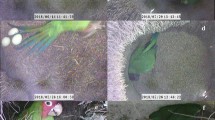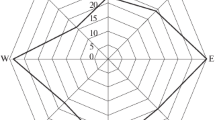Abstract
We examined nesting behavior in monk parakeets (Myiopsitta monachus) in their native habitat in the Brazilian Pantanal. Unique among parrots, monk parakeets build communal nest structures that contain many cavities, each belonging to an individual pair. We studied 41 parakeet colonies that had 104 nest structures. We hypothesized that nest structures would be located in trees providing the greatest support and protection from predators and inclement weather, and that nest sites and nest cavities would differ from random locations with respect to tree characteristics, location of houses, and presence of jabiru stork (Jabiru mycteria) nests, as suggested anecdotally by other authors. Fewer than half of the colonies were close (<350 m) to houses. There was a strong association with jabiru storks; 21 of 23 stork nests had monk parakeet nest cavities attached, accounting for 51% of parakeet colonies. Of the 21 jabiru-associated colonies, 6 had additional parakeet structures and 15 had only the jabiru-attached parakeet structure. Monk parakeet colonies associated with jabiru nests had significantly more nesting cavities than did monospecific monk parakeet colonies, due mainly to those attached directly to the jabiru nest. In jabiru-associated colonies, parakeet nest structures were located higher and in taller trees than in monospecific colonies. There was no difference in trunk diameters of parakeet nesting trees with or without jabirus. Although we tabulated 24 tree species as nest trees, nearest-neighbor trees, or matched-point trees, only 6 species were used for nesting. When compared to matched points, monk parakeet structures were preferentially located in piuva (Tabebuia spp.) and mandovi trees (Sterculia apetela). Parakeet structures were in taller trees with thicker trunk diameters than matched points. Most nest cavities (71%) faced in a northerly direction (northwest to northeast), away from cold southerly winds. Choice of a nest site and orientation appears to reflect structural, weather, and predator constraints. Thick, tall trees with stout branches provided stable sites for their large nest structures, which are known to collapse because of their own weight and strong winds. Nesting with jabirus confers structural advantages (they could attach many nests to the bottom of the jabiru nest, potentially gaining benefits from social facilitation), early warning, and predator defense.





Similar content being viewed by others
References
Beissinger SR, Snyder NFR (1992) New world parrots in crisis: solution from conservation biology. Smithsonian Institution Press, Washington, D.C.
Bucher EH, Martin LF, Martella MB, Navarro JL (1991) Social behaviour and population dynamics of the monk parakeet. Proc Int Ornithol Congr 20:681–689
Bump G (1971, May) The South American monk, Quaker, or gray-headed parakeet. (Wildlife leaflet) U.S. Fish and Wildlife Service, Washington, D.C.
Burger J, Gochfeld M (2000) Nest site selection in monk parakeets (Myiopsitta monachus) in Florida. Bird Behav 13:99–105
Darling FF (1938) Bird flocks and the breeding cycle. Cambridge University Press, Cambridge
Darwin C (1839) Journal of researches into the natural history and geology of the countries visited during the voyage of H.M.S. Beagle. Henry Colburn, London
Eberhard JR (1996) Nest adoption by monk parakeets. Wilson Bull 108:374–377
Eberhard JR (1998) Breeding biology of the monk parakeet. Wilson Bull 110:463–473
Forshaw JM (1973) Parrots of the world. Doubleday, Garden City, NY
Friedmann H (1927) Notes on some Argentine birds. Bull Mus Comp Zool 68:177–178
Garber S (1993) Is the monk parakeet the ecological equivalent of North America’s extinct Carolina parakeet? Focus 43(3):26–30
Gibson E (1880) Ornithological notes from the neighbourhood of Cape San Antonio, Buenos Ayres. Ibis 1880:1–38
Gibson E (1919) Further ornithological notes from the neighbourhood of Cape San Antonio, Province of Buenos Ayres. Ibis 1919:495–537
Gilardi JD, Munn CA (1998) Patterns of activity, flocking, and habitat use in parrots in the Peruvian Amazon. Condor 100:641–653
Gochfeld M (1973) Ecologic aspects of ectopic populations of monk parakeets (Myiopsitta monachus) and possible agricultural consequences. J Agric Univ P R 57(3):262–270
Gore MEJ, Gepp ARM (1978) Las Aves del Uruguay. Mosca Hermanos S.A. and Int. Council Bird Preservation, Montevideo
Holland AH (1892) Short notes on the birds of the Estancia Espartilla, Argentine Republic. Ibis 1892:193–214
Hudson WH (1920) Birds of La Plata. Dent, London
Humphrey PS, Peterson RT (1978) Nesting behavior and affinities of monk parakeets of southern Buenos Aires Province, Argentina. Wilson Bull 90:544–552
Hyman J, Pruett-Jones S, (1995) Natural history of the monk parakeet in Hyde Park, Chicago. Wilson Bull 104:413S–424S
Juniper T, Parr M (1998) Parrots: a guide to parrots of the world. Yale University Press, New Haven, CT
Lanning DV (1991) Distribution and nest sites of the monk parakeet in Bolivia. Wilson Bull 103:366–372
Martella MG, Bucher EH (1990) Vocalizations of the monk parakeet. Bird Behav 8:101–110
Martin LF, Bucher EH (1993) Natal dispersal and first breeding age in monk parakeets. Auk 110:930–933
Naumberg EMB (1930) The birds of Matto Grosso, Brazil. Bull Am Mus Nat Hist 60:18,128
Navarro JL, Martella MB, Bucher EH (1992) Breeding season and productivity of monk parakeets in Cordoba, Argentina. Wilson Bull 104:413–424
Navarro JL, Martella MB, Bucher EH (1995) Effects of laying date, clutch size, and communal nest size on the reproductive success of monk parkakeets. Wilson Bull 107:742–746
Neidermyer WJ, Hickey JJ (1977) The monk parakeet in the United States, 1970–1975. Am Birds 31:273–278
Oliveira PS, Marquis RJ (2002) The cerrados of Brazil: ecology and natural history of a neotropical savannah. Columbia University Press, New York
Pott A, Pott VJ (1997) Plants of the Pantanal. Servico de Producao de Informacao SPI, Brasilia, Brazil
Pruett-Jones S, Tarvin KA (1998) Monk parakeets in the United States: population growth and regional patterns of distribution. Proc 18th Vertebr Pest Conf 18:55–58
SAS (Statistical Analysis Systems) (1995) SAS users’ guide. Statistical Institute, Cary, NC
Serie P, Smyth CH (1923) Notas sobre aves deSanta Elena (E. Rios). Hornero 3:37–55
Sol D, Santol DM, Feria E, Clavell J (1997) Habitat selection by the monk parakeet during colonization of a new area in Spain. Condor 99:39–46
Sparks J, Soper T (1990) Parrots: a natural history. Facts on File, New York
Spreyer MF, Bucher EH (1998) Monk parakeet. Birds of North America 322. American Ornithologists’ Union, McLean, VA
Stevenson HM, Anderson BH (1994) The bird life of Florida. University of Florida, Gainesville, FL
Temple SA (1992) Exotic birds: a growing problem with no easy solution. Auk 109:395–396
VanBael S, Pruett-Jones S (1996) Exponential population growth of monk parakeets in the United States. Wilson Bull 108:584–588
Westcott DA, Cockburn A (1988) Flock size and vigilance in parrots. Aust J Zool 36:335–349
Wetmore A (1926) Observations on the birds of Argentina, Paraguay, Uruguay, and Chile: Myiopsitta monachus monachus. US Natl Mus Bull 133:192–196
Acknowledgements
The authors wish to thank Juliano Penato de Arruda for his guiding services while we were at Caranda and for aiding in tree identification, and Luiz and Marina Vicente for logistical help, identification of tree species, and directions to parakeet colonies at Pouso Alegre. The staff of Fazenda Caranda, Pouso Alegre, and Pousada Piuval also helped locate monk nests and jabiru nests on the savannah. All these people helped make our work both pleasant and productive. Two anonymous referees provided valuable comments.
Author information
Authors and Affiliations
Corresponding author
Additional information
Communicated by R. Oliveira
Rights and permissions
About this article
Cite this article
Burger, J., Gochfeld, M. Nesting behavior and nest site selection in monk parakeets (Myiopsitta monachus) in the Pantanal of Brazil. acta ethol 8, 23–34 (2005). https://doi.org/10.1007/s10211-005-0106-8
Received:
Revised:
Accepted:
Published:
Issue Date:
DOI: https://doi.org/10.1007/s10211-005-0106-8




